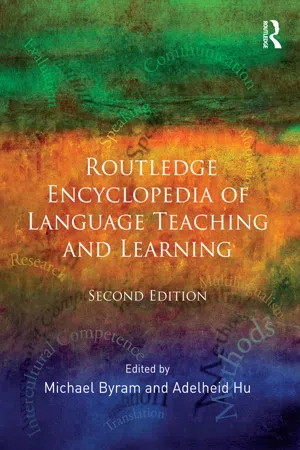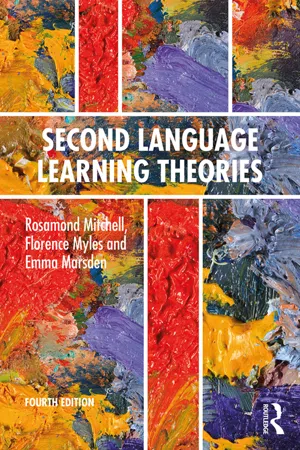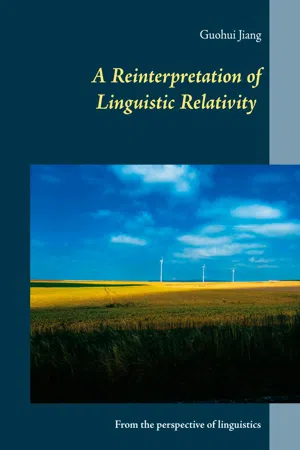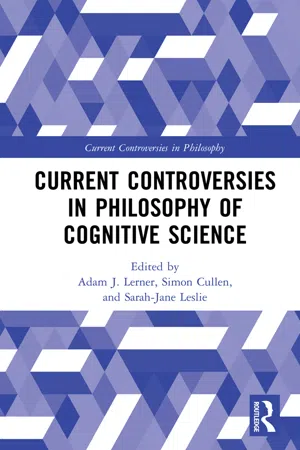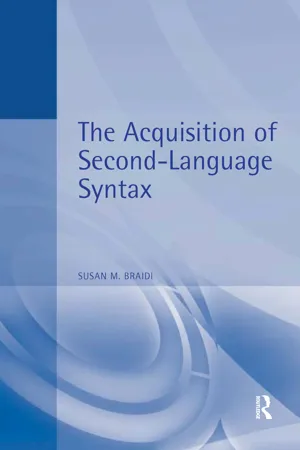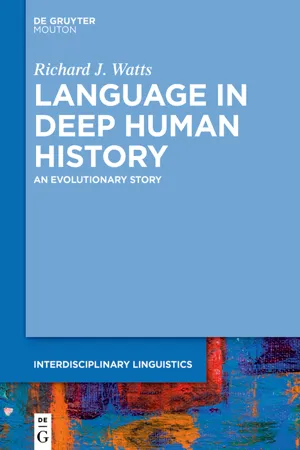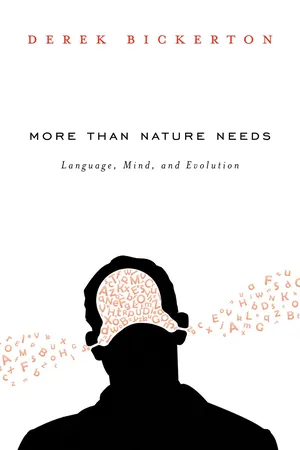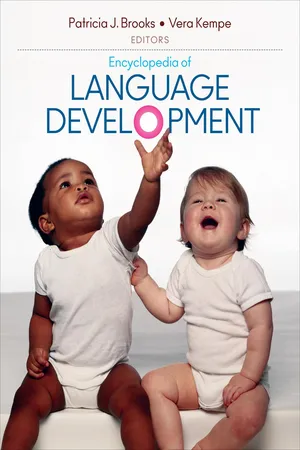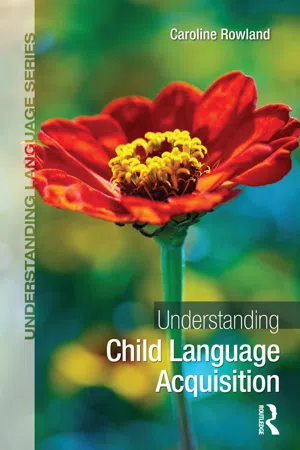Languages & Linguistics
Universal Grammar
Universal Grammar is a theory proposed by Noam Chomsky, suggesting that all languages share a common underlying structure. According to this theory, humans are born with an innate ability to understand and produce language, and this universal grammar serves as the foundation for language acquisition. It posits that the diversity of languages arises from variations in the parameters of this innate grammar.
Written by Perlego with AI-assistance
Related key terms
Related key terms
1 of 4
Related key terms
1 of 3
10 Key excerpts on "Universal Grammar"
- Michael Byram, Adelheid Hu(Authors)
- 2013(Publication Date)
- Routledge(Publisher)
U
DOI: 10.4324/9780203101513-26Universal Grammar (UG)
Since the 1950s the developing theories of Noam Chomsky have been a major inspiration for linguistics. The first version was known as ‘transformational generative grammar’ after two key concepts: language should be described in explicit formal rules (generative) and these rules must be able to alter elements in the sentence in various ways (transformations). The later version became known as ‘Universal Grammar’ (UG) theory after the central claim that language should be looked at in universal terms, then as ‘principle and parameters’ theory after the way it described language through universal ‘principles’ that all languages obey, and variable ‘parameters’ that change from one language to another. Then it became the ‘Minimalist Program’ after its quest to reduce all its apparatus to the basic minimum (Chomsky, 1995 ). Above all the UG theory has integrated language acquisition with language description, seeing acquisition as setting the values for these parameters appropriately according to the examples of language the learner hears.Chomsky (1986) set three main questions for linguistics:- What constitutes knowledge of language?
- How is such knowledge acquired?
- How is such knowledge put to use?
The starting point is what people know about language, their internal ‘linguistic competence’, not their actual speech or use, their external ‘performance’, nor their purposes in using language, such as communication. This knowledge cannot be separated from how it comes into being; hence language description gets intertwined with theories of language acquisition.Universal Grammar is the distinct part of the mind common to all human beings that enables them to know and acquire languages. The language ‘faculty’ is a separate part of the mind, thus distinguishing UG theory from general psychological theories that see language and language learning as intrinsically no different from any other mental process. The stress on knowledge implicitly contradicts many approaches to language teaching, such as the social bias to the communicative approach or the goal-based claims of task-based teaching; the emphasis on independence similarly goes against teaching methods that employ general ideas of learning, such as the habit formation concept integral to the audio-lingual method- eBook - ePub
Second Language Learning Theories
Fourth Edition
- Rosamond Mitchell, Florence Myles, Emma Marsden(Authors)
- 2019(Publication Date)
- Routledge(Publisher)
First in this chapter, we will give a broad definition of the aims of the Chomskyan tradition in linguistic research, in order to identify the aspects of second language acquisition (SLA) to which this tradition is most relevant. Secondly, we will examine the concept of UG itself in some detail, and finally we will consider its application in L2 learning research.3.2 Why a Universal Grammar?
3.2.1 Aims of Linguistic Research
The main goals of linguistic theory, as defined by Chomsky (1986a), are to answer three basic questions about human language:- What constitutes knowledge of language?
- How is knowledge of language acquired?
- How is knowledge of language put to use?
1. What Constitutes Knowledge of Language?
From a generative perspective, linguistic theory aims to describe the representations of language which are stored in the human mind. It aims to define what all human languages have in common, as well as the distinctive characteristics which make human language different from other systems of communication. It also needs to specify in what ways individual human languages can differ from one another, as they clearly do. However, Chomsky (e.g. 2000) argues that to a Martian landing on Earth, the differences between human languages would seem like variations on a single theme.The UG approach views language as a genetic endowment. In the 1980s, this was conceptualized by claiming that all human beings inherit a universal set of abstract principles and parameters which constrain (limit) the shape human languages can take, and which make human languages similar to one another. In his Government and Binding - eBook - ePub
A Reinterpretation of Linguistic Relativity
From the perspective of linguistics
- Guohui Jiang(Author)
- 2020(Publication Date)
- Books on Demand(Publisher)
I. Universal Grammar in Chomskian sense represents the initial state of the function of language; it is the innate ability thanks to which human is able to acquire language. The syntax of every language describes surface structures of sentences, whereas the Universal Grammar establishes the deep causes of these surface syntactic structures.II. Universal Grammar is common to all languages which resemble certain abstract and formal software, innately stipulating the structural principle of human language and defining “what-is-possible” and “what-is-impossible” for all human languages.In this regard GL is even in contrary to GRG which concentrates on commonality of logic and content of human thinking, stipulating seemingly the commonality of grammatical categories of languages; whereas GL attempt to involve in its study of human linguistic faculty as little as possible content (thought) behind grammatical structures, thus the postulations of GL is not directly related to the thought and reality, the important objects of LR study. Even if GL must be regarded as the contemporary representative of LU, the universality discussed in GL is in fact beyond the scope of LR study, for the object of the LR study is not the language itself as a semiotic system, but the epistemological essence of language for human observation and understanding of the objective world. The opposition of LU vs. LR with respect to GL remains thus no more than the opposition of the meaning of the words “universality” and “relativity”.Particular worldview of native speakers of each particular language means that in their everyday life ordinary people can observe, understand and describe reality only in conformity with their mother tongue – this principle of LR is universal for all human languages. The worldview, shaped by language in virtue of its grammatical categories and vocabulary, will certainly vary from one group of people to another in accord with the languages they speak, but LR cannot in this sense be counterposed to GL as “relativity vs. universality”. GL advocates the universal human inner ability owing to which human can acquire and perform language; whereas the relativity effect in terms of language-thought-reality relation LR postulates is also universal for all human languages: Native speakers of each language might understand reality in a particular way, differing from that of native speakers of other languages; yet human beings, no matter they are native speakers of which language, will in the same way and to the same extent be constrained by language when they talk/think about reality. - Adam J. Lerner, Simon Cullen, Sarah-Jane Leslie, Adam J. Lerner, Simon Cullen, Sarah-Jane Leslie(Authors)
- 2020(Publication Date)
- Routledge(Publisher)
Part I Is There a Universal Grammar?Passage contains an image
Paul Pietroski and Norbert Hornstein1 Universal GrammarPity the linguist. By tradition, the job is to describe languages in ways that extend the ancient practice of providing grammars (e.g., for Sanskrit or Latin). Modern linguists are also expected to be cognitive scientists who study some aspect of human psychology that supports the acquisition and use of languages that children readily attain. Given the tradition, linguists inherit a lot of terminology—e.g., ‘sentence’, ‘subject’, ‘word’, ‘language’, and ‘grammar’—that cannot be discreetly consigned to the attic. So old terms often get used in new ways. As a result, ‘Universal Grammar’ has meant different things for different people at different times. But the phrase does focus attention on a good idea: The diverse languages that children can naturally acquire exhibit shared features that reflect traits shared by all members of our species.1. Laying a New Picture on an Old One
Let’s start with the obvious fact that nothing does language like humans do language. Other animals communicate. But we talk—a lot. Our distinctive loquacity is manifested along many dimensions, two of which are especially important here. First, humans are linguistically creative, in that we routinely produce and understand expressions that we have never before produced or encountered. Indeed, there seems to be no upper bound on the number of expressions that a native speaker can linguistically manage. Second, the languages that humans can naturally acquire are universally available to children. To be sure, experience matters. Native speakers are only adventitiously proficient in the languages they happen to have acquired. But there are no subgroups of humans who can only acquire languages from certain families (e.g., Indo-European). Given the right experience, any ordinary child can become a speaker of any of the languages that other children can acquire.- eBook - ePub
- Susan Braidi(Author)
- 2020(Publication Date)
- Routledge(Publisher)
3Universal Grammar3.1 Introduction
With the development of the notion of Universal Grammar (UG) within the generative theory of Government and Binding (Chomsky 1981) came a renewed interest in the application of generative theory to L2 acquisition (Newmeyer 1983; White 1987a, b). This interest was in part strengthened by the formulation of specific principles and parameters that could be tested empirically and that accounted for cross-linguistic variation, an important issue in L2 acquisition. Interest was also generated by similar research in the application of UG to LI acquisition. Still other researchers found applications to L2 classroom instruction in the UG paradigm.Chomsky's later theoretical revisions (Barriers (1986a) and the Minimalist Program in 1992) have modified the theoretical explanation for many of the principles and parameters on which much of the L2 research is based. These revisions have therefore changed the questions that need to be asked in L2 research. As White (1995) points out, keeping abreast of the changes in a developing theory is both advantageous and problematic. While a changing theory offers new perspectives on language-acquisition data, it also presents practical challenges to the researcher in formulating questions and testing those questions.In this chapter we first introduce the various principles and parameters of UG that have been investigated in L2 acquisition, illustrate how the different parameter settings are manifested in language, and discuss some of the relevant theoretical shifts. The second section of the chapter examines some of the questions that have been investigated in L2-acquisition research in more detail. This research focuses on the issues of UG accessibility in L2 acquisition, LI transfer and parameter resetting, and input. Because of the extensive amount of research in this paradigm, it is necessary for students to understand this work in order to understand L2 acquisition of grammar. At the same time, it is important to understand how the assumptions underlying the research in the UG paradigm differ from those of other approaches, and how earlier theoretical concepts have been reformulated within the UG approach. - eBook - ePub
Language in Deep Human History
An Evolutionary Story
- Richard J. Watts(Author)
- 2024(Publication Date)
- De Gruyter Mouton(Publisher)
genetic components. For the moment I will focus exclusively on UG. If UG were a genetic component, some part of the human genome would encode it, which explains why there is so much media excitement whenever a team of geneticists suggest that gene X is a “language gene” (see the previous section). As we saw, linguists who support this idea are usually quick to suggest that the UG module is innate—generally without ever defining exactly what they understand by the term “innate”. UG sets constraints on how the grammar of any human language is defined, the most fundamental constraints being syntactic, and these are presented in the manner of algebraic equations defining what components go together by means of what rules to make up larger components within the framework of a set of principles and the parameters in which they operate, on the assumption that they are universally valid across all languages.One of the major problems encountered by the theory, however, is to determine what exactly those principles and parameters (or language universals) are, given the rich diversity of language types to be found in the world. Since children acquire the language (or languages) to which they are exposed so quickly from the age of around one year with what is argued to be a restricted amount of language used to them and in their presence by conspecifics, this is taken as empirical evidence for the existence of an innate language faculty in every child. The so-called “poverty of the stimulus” argument has always been in contention, and Chomsky’s present position with regard to UG is that if children appear to be able to place words relatively easily into such syntactic categories as noun, verb, adjective, etc., and to guess whether the language they are learning is verb-initial, verb-final or verb-intermediate in clause structure, this may indicate that UG is much simpler and more abstract than was originally assumed. From this he now proposes, in what he calls the Minimalist Program, that there is only one mechanism for combining symbols in different ways, which he defines as the operation of Merge. Since that principle is universal to all languages and is, by the way, also a part of how human beings conceptualise (cf. double-scope blending), it is not part of the environment and is thus regarded as genetically determined. - eBook - ePub
Certainty in Action
Wittgenstein on Language, Mind and Epistemology
- Danièle Moyal-Sharrock(Author)
- 2021(Publication Date)
- Bloomsbury Academic(Publisher)
22 and how languages vary radically in sound, meaning and syntactic organization. Where there are significant recurrent patterns in organization, these are better explained as stable engineering solutions satisfying multiple design constraints, reflecting both cultural-historical factors and the constraints of human cognition. So that ‘… the great variability in how languages organize their word-classes dilutes the plausibility of the innatist UG position’ (2009, 429; 435). Research on syntax have brought Dunn et al to conclude that there is no universal set of rules determining the evolution of language; rather, it is cultural evolution that is the primary determinant of linguistic structure, at least with respect to word order (2011, 79).The notion of an innate structure of mind imposing ‘universals’ has also been rejected from a biological perspective. As Wolfram Hinzen affirms, there is no clue, empirically, about the type of rule that would be able to organize neuronal connections that enable language competence; there is no biology specific to language; no Universal Grammar rooted in the human genome (2012a, 636). This chimes with Christiansen and Chater’s findings: ‘a biologically determined UG is not evolutionarily viable’ in that the processes of language change are much faster than processes of genetic change, so that language constitutes a ‘moving target’ both over time and across different human populations and cannot therefore provide a stable environment to which language genes could have adapted (2008, 489). And Terence Deacon abundantly demonstrates that Chomsky’s scenario is unsupported by evolutionary anthropology which evidences a gradual adaptation of the human brain and vocal chords to the use of language rather than the sudden appearance of a language organ containing a complete set of parameters enabling all grammars23 – Chomsky’s ‘Big Bang’ theory.24 - eBook - ePub
- Derek Bickerton(Author)
- 2014(Publication Date)
- Harvard University Press(Publisher)
Curiously, while showing that many previously claimed universals are not really universal, Evans and Levinson avoid mention of two universals that form part of the fundamental structure of every sentence in every human language. This is perhaps because nobody I know of has ever claimed them as universals, which must seem a surprising fact for nonlinguists (as it was for me when I first realized it). Perhaps it is precisely because these universals are so surface, so obvious, and so much taken for granted that linguists simply haven’t thought of them or haven’t thought them worthy of mention. Yet all sentences in all languages consist of phrases and clauses, and all phrases and clauses are constructed in essentially the same way, bear the same relations with one another, and enter into combinations of the same type. It is far from clear that this was inevitable. No known laws of nature enforce it, and at least one possible alternative—a language consisting solely of noun phrases—has been proposed and defended by Carstairs-McCarthy (1999).Given an automatic mechanism for creating phrases and clauses, much of the rest of syntax follows logically or can be inferred, and what is left can be learned by good old general-purpose learning mechanisms. Some later sections of this chapter return to this issue, which will form an important theme recurring throughout the remaining chapters, especially Chapter 6 .The “Impossibility” of Universal Grammar
Some scholars go further than denying the existence of language universals. They claim that it is logically impossible for language universals to exist. The most comprehensive attempt to do this comes from Christiansen and Chater (2008). The position they start from is a strange one. Though the title of their article is “Language as Shaped by the Brain”—which, taken literally, is exactly the theme of this chapter—they mean by it something completely different. They propose that “language has adapted through gradual processes of cultural evolution to be easy to learn to produce and understand” (490).Commentators on this article (among others, Harnad 2008; Piattelli-Palmarini et al. 2008) have pointed out some of the problems with this formulation. For instance, as it is stated it bears a “glass half-full/half-empty” relationship to orthodox Chomskyan proposals (surely counter to anything the authors intended), and it illegitimately reifies language as an extrahuman object with an identity, goals, and purposes of its own. More critically it logically entails that earlier versions of language must have been harder to learn to produce and understand - eBook - ePub
- Patricia J. Brooks, Vera Kempe(Authors)
- 2014(Publication Date)
- SAGE Publications, Inc(Publisher)
Noam Chomsky first proposed the theory of generative grammar in 1955. After nearly half a century, this theory still provides an indispensable framework that allows us to trace—with intricate precision—the virtually identical acquisition paths children follow in acquiring language. The challenge is to explain how children select just the right grammar for their language from all of the possible grammars in a short period of time—despite the lack of evidence of organizing principles in the input they receive. Chomsky made the famous poverty of stimulus argument, suggesting that the grammars of human languages are essentially unlearnable given the limited input provided to children: Parents do not really correct their children; that is, no one tells their child that what he or she has said is ungrammatical. Because the grammar operates on the timescale of milliseconds, an automatic mechanism, rather than a deliberative process, must be at work. Chomsky proposed that the grammatical mechanism comprises unconscious rules that project hierarchical structure and constrain movement of structures. The grammar is generative in the sense that its rules are designed to allow for the infinite expression of creative ideas and feelings.This entry focuses on three technical ideas crucial to the generative grammar framework: (1) labeled hierarchical structure; (2) movement, that is, the interpretation of a displaced element far from its origin; and (3) restricted recursion in syntax. These concepts have received extensive empirical support in the acquisition literature; this entry focuses on a few key examples. The most startling fact is that children’s grammar complies, at every step, with the abstract principles proposed for adult grammar.Merge
The first fact about language acquisition to appreciate is that children never just combine words as equals; they always impose an asymmetrical structure in which one word is a head. This constraint-blocking symmetrical merge appears to be an innate part of Universal Grammar, which provides a template for the possible grammars of human languages. - eBook - ePub
- Caroline Rowland(Author)
- 2013(Publication Date)
- Routledge(Publisher)
Although it is difficult to pin down what features may be true of all languages (i.e. present in UG), we cannot conclude just yet that these features do not exist. The debate is still live and the existence of UG remains highly disputed. Some argue that it is premature to conclude that UG does not exist just because we have not hit on the right universal features yet (Nevins, 2009; Rizzi, 2009). It is difficult to dispute the logic of this argument, although it may be possible to argue that people are looking in the wrong place. For example, Tomasello strongly urges researchers to look for universals in the “universal processes of human cognition, communication and vocal-auditory processing” rather than searching for innate linguistic principles (Tomasello, 2005, p. 189).Second, in our investigation of the mechanisms behind language acquisition, we assessed three answers to the following key question: What mechanisms are required to acquire language, and which of these might be unique to language or to humans?Pinker and Jackendoff (2005) have argued that many of the mechanisms required for language must have evolved in humans specifically for this purpose. Hauser, Chomsky and Fitch (2002) disagree. They suggest that only recursion is unique to humans and to language, with elements of all other mechanisms shared with other species or other cognitive functions. Finally, ‘new machine’ theorists argue that nothing need be unique to humans or to language. What is unique is simply the way in which a number of substrate mechanisms have evolved to interact. The language mechanisms make up a “new machine built out of old parts” (Bates et al., 1991, p. 35).The debate about the nature of the language mechanism is unlikely to be resolved in the near future. However, this is partly because it is central to everything that language acquisition researchers do. Learning a language is the most complex, difficult task we will ever master in our lives. Yet children find it easier and more effortless than learning to ride a bike. If we ever do, finally, discover the mechanisms responsible for this incredible accomplishment, it will be time to go home, sit down and put our feet up, in the knowledge of a job well done.9.6
Index pages curate the most relevant extracts from our library of academic textbooks. They’ve been created using an in-house natural language model (NLM), each adding context and meaning to key research topics.
Explore more topic indexes
Explore more topic indexes
1 of 6
Explore more topic indexes
1 of 4
